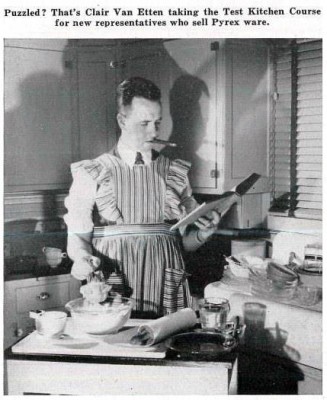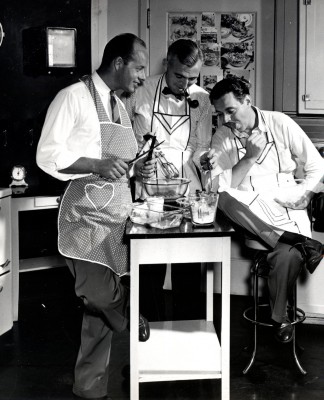Typewriters clattering, designers at drafting tables, phones ringing—all the sights and sounds of a typical 1930s office building, but in the offices of Corning Glass Works amid the typical business activity wafted scents of roasting chicken and baking cakes. Pyrex’s test kitchen, supervised by Lucy Maltby, the director of Corning Glass Works Home Economics Department, was located in the center of Corning Glass Works administration building. The test kitchen evaluated product designs, mined consumer reviews, suggested design innovations, and, as a result, sold more Pyrex.

Dudley Olcott, Clair Van Etten, Harry Hormell, Harry Cook, and Lilla Cortright. Photography by Ayres Stevens, Corning Glass Works Gaffer, October 1946.
Maltby and her staff also developed recipes and trained a mostly male Corning Glass Works sales force to boil water, prepare dough and batter, and make coffee and tea.
- Clair Van Etten taking the Test Kitchen Course. Photography by Ayres Stevens, Corning Glass Works Gaffer, October 1946.
- R.F. Barlow, G.J. Mackey, and E.E. Shankin training in the Test Kitchen. Photography by Ayres Stevens, 1946. Courtesy of Corning Incorporated, Department of Archives and Record Management.
Home economists of the 1930s considered their work a science—the science of the home—and Maltby ran her test kitchen according to standards expected of a scientific authority. A disciplined businesswoman, Maltby was rigorous in the task of conducting experiments in her test kitchen laboratory.

Mary Louise Linneman (1909–1972), first Home Economist hired under Dr. Lucy Maltby. A.G. Ayres, photographer, Corning, NY, 1930. Courtesy of Corning Incorporated, Department of Archives and Record Management.
In 1951, the Pyrex double boiler was tested alongside 14 different styles of double boilers from competitors. The test kitchen staff prepared the same recipes in each double boiler to answer the questions: How did the double boiler cooking times and temperatures compare? To what degree did the handles heat up? Could both pans be lifted at once? Was there a measurable standard of stability? Could the pans be easily cleaned and stored?
The results of the double boiler experiments went to the Pyrex designers and engineers, and the outcome was the new Pyrex double boiler. A 1953 article in the Corning Glassmaker, a company magazine, outlined the improvements achieved in the new double boiler:
- Food heats faster, more economically, because more pan surface touches the water or is exposed to steam.
- Both pans have flatter and broader bottoms, can be easily used as separate saucepans.
- Lower all-over height, can be easily used with an egg beater by a short girl.
- Cover knob easier to grasp.
- Handles close together, both pans can be picked up at the same time.
- Good pouring, liquid can be poured from both pans.
- Tight fitting pans, steam leakage reduced, at the same time top pan can be removed easily.

Helen Martin, Lilla Cortright, Mary Alice Dailey prepare foods to be photographed in Pyrex Dishes. Photography by Ayres Stevens, published in Corning Glass Works Gaffer, October 1946. Courtesy of Corning Incorporated, Department of Archives and Record Management.
The idea of a test kitchen for Corning Glass Works was in the air before Maltby’s time. Jessie Littleton, Corning Glass Works physicist, recommended a test kitchen in 1918. But it was Lucy Maltby who made the test kitchen a reality, and her contribution shaped the design, manufacture, and sales of Pyrex for decades.


